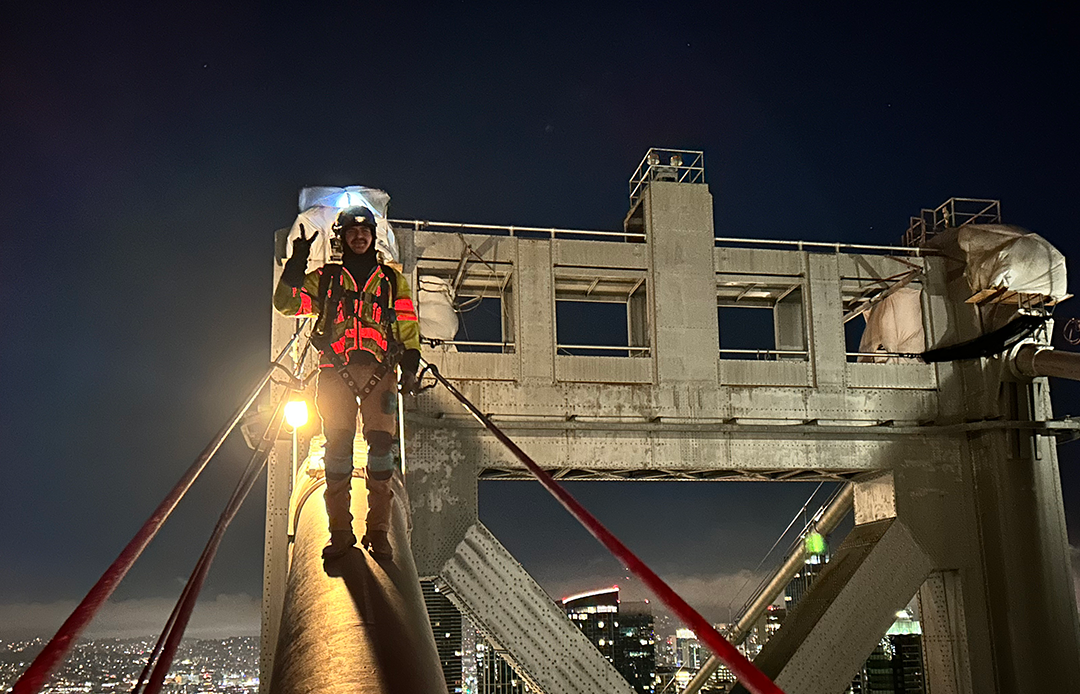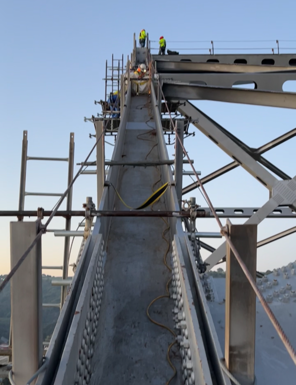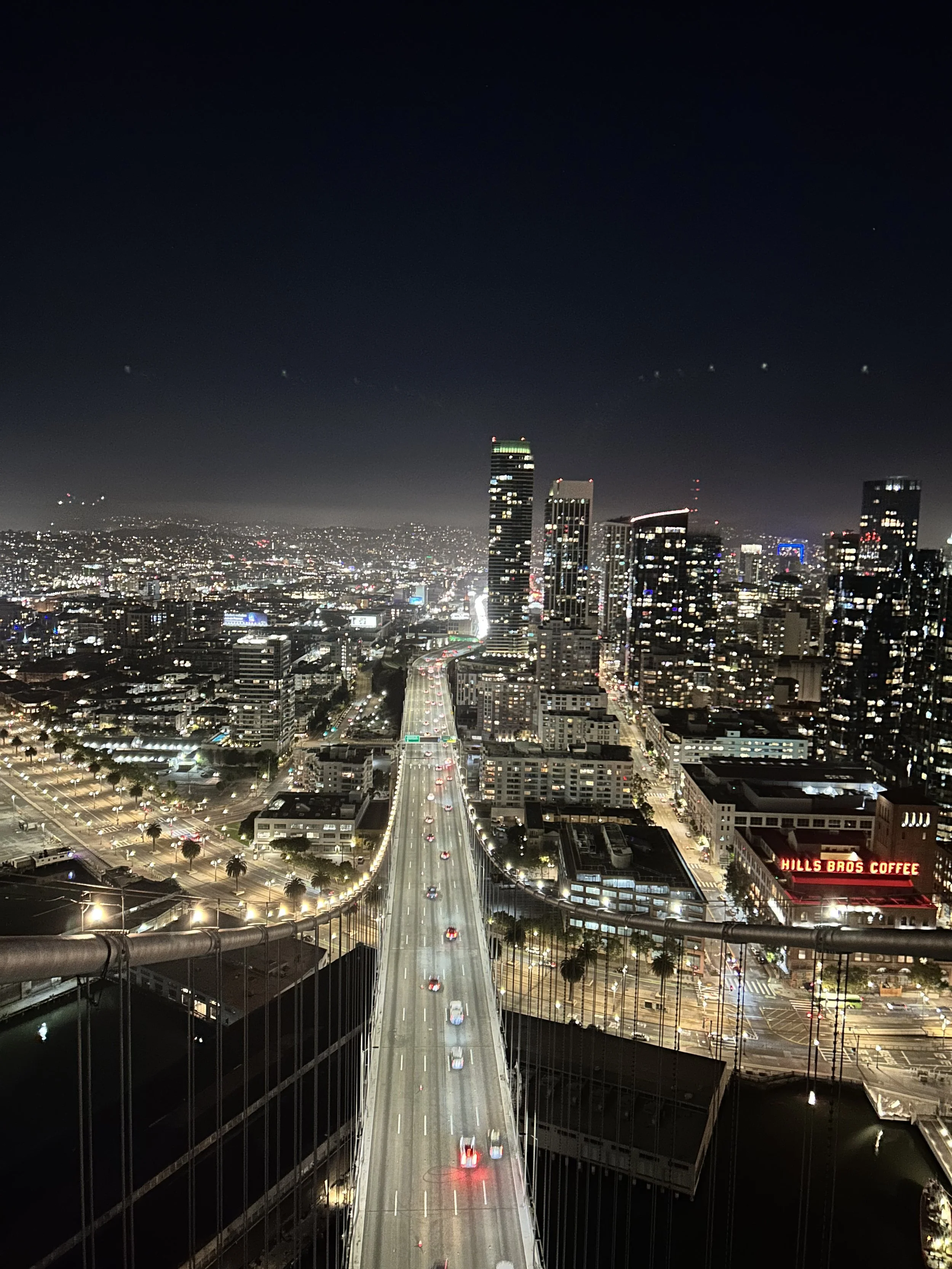Bridge Work Keeps San Francisco Moving
How ironworkers, painters maintain, restore Bay Area’s many crucial spans
GOLDEN GATE BRIDGE IRONWORKERS Chris Bowler, Isaac Moreno Arce, and Nicky Carrillo install an access platform underneath the bridge. | Credit: Golden Gate Bridge, Highway & Transportation District
Local union members are instrumental in ensuring San Francisco’s bridges remain open, smoothly operating, and in good condition. Two sets of building trades workers, in particular, are at the forefront of this effort: members of Ironworkers Local 377 and painters with District Council 16 (DC 16).
“We do the day-to-day maintenance and repairs, from replacing rivets, lacings, and different sizes of plates to engaging in steel weathering for components like I-beams,” said Nicky Carrillo, superintendent ironworker and operating engineer for the Golden Gate Bridge, Highway, and Transportation District. “We inspect parts like the stanchions and the vertical support elements on the cables. Sometimes we build platforms, scaffolding, and containments for painters members.”
Working on the bridge is a continual process, Carrillo added, with certain tasks performed on a regular schedule.
The ironworkers who work directly for the district also have an unlisted volunteer task in their job description: rescuing individuals who attempt suicide and must be brought up from suicide prevention nets or areas underneath the bridge.
Painters members typically remove lead-based paint and rust from bridges. They then coat steel plates and parts with protective chemical sprays.
Former DC 16 painter Ben Regalado helped make improvements to the Carquinez Bridge between Crockett and Vallejo in 2023 and 2024 before retiring later in 2024.
“It’s a lengthy process — stripping the old paint off the steel, grinding off the rust, applying primer, and spraying your coatings.” Regalado said. “You do this high up, often in harsh temperatures. Factors like fog make the job more complicated.”
The list of requirements for both ironworkers and painters who work on the bridges includes the ability to work at extreme heights. As members of a team, workers need to cooperate and listen. They also have to be organized and prepared — to always be “on top of it.” Every time a worker goes up on a bridge, they must be aware of how their critical gear is performing, be it a harness or a sprayer.
Lisa Davidson is a foreman and member of Ironworkers Local 377. She has worked on the Golden Gate Bridge under a subcontractor since 2019.
“This is eight- to 10-hour-a day-work, where you’ve got to be on your game every minute,” Davidson said. “It’s a killer workout, but the job’s a total adrenaline rush. The benefit is that every time you see or cross a bridge you worked on, you remember how you contributed.”
IRONWORKERS WORK ON THE BRIDGE. Click above photos to expand. | Credit: Golden Gate Bridge, Highway & Transportation District
Major Differences in Union Practices
The ironworkers and the painters view and use technology differently. The ironworkers tend to utilize a lot of hands-on, basic tools, including spud wrenches, crescent wrenches, and pliers, as opposed to high-tech tools like drones.
“We’re super scrappy,” said Davidson. “Ironworkers are known for figuring out solutions with the tools we’ve got. We’ll throw [ourselves] at a problem until we figure out how to solve it.”
Painters, meanwhile, use many advanced sprayers and application machines, such as plural component pumps, which mix separate paint materials so that they can be sprayed simultaneously. Such tools can be pricey, with some devices costing up to $40,000. Painters’ equipment can be so expensive that only one person on a team might have the training and certification needed to operate certain machines.
Both unions work with their bridge’s engineering team to come up with a work plan. They also develop a rescue plan — the basic to-do list for starting a job — and methods to keep all workers safe during tasks such as spraying in a containment.
“We have to look at what’s feasible and who can do what,” Carrillo said.
A PAINTER JOURNEYMAN member of District Council 16 engages in night work on the Bay Bridge. | Photo: Tanner Carroll
Tanner Carroll, a painter currently working with DC 16, has worked on the Bay Bridge, the Golden Gate Bridge, and the Mare Island Causeway Bridge in Vallejo. He said painters often follow ironworkers, “working after them” to spray coatings on finished bridge sections.
The ironworkers use ATVs or smaller enclosed-cabin utility carts they refer to as scooters to transport themselves to work points on the bridge.
On the San Francisco side of the Golden Gate Bridge, the ironworkers have a machine shop located in the back of a maintenance yard behind the bridge’s toll station office. The shop is where they weld and repair removable parts of the bridge that are fixable. Occasionally, they craft awards from decommissioned bridge components and present them to long-time workers.
One of the most important things regarding bridge work is to make the most of the time when a crane is in operation — work that always occurs on the night shift.
“A crane means money,” ironworker foreman Davidson said. “You want to use every minute of that time when it’s out there.”
In a typical work schedule, there are both night crews and day crews, she said.
“The two crews work together to help one another out,” Davidson said. “The night crew feeds the day crew, and vice versa.”
PAINTERS at work in containment areas perform lead abatement on steel plates. Members needle-gun and angle-grind the lead coating to ensure lead flakes don’t escape over the sides of the bridge and into the ocean. | Photo: Ben Regalado
The Golden Gate Bridge District has in-house union painters and a roadway services team that performs traffic control on the bridge. On special projects, some painting and traffic control will be performed by contractors in coordination with bridge staff.
While Caltrans does not perform any structural steel painting or traffic control on the Golden Gate Bridge, the agency does employ union painters who do such painting on other local bridges. These painters are generally either part of Caltrans’ regular maintenance workforce or are brought in to work on special projects. The agency often assists union members who are at work on a bridge by closing lanes and directing traffic away from laborers and equipment.
“Caltrans has the deepest respect for ironworkers, painters, and all members of the trades,” said Bart Ney, office chief of public affairs and strategic communications for Caltrans Bay Area.
The supervising staff of the ironworkers and painters collaborate with staff from the California Highway Patrol, the Golden Gate Bridge Patrol, and fire departments and districts such as the San Francisco Fire Department and the Southern Marin Fire Protection District. These agencies assist union members with traffic safety operations and emergency measures as needed.
Working Under Tough Conditions
Bridge work is especially treacherous in difficult weather. In high winds, heavy fog, and rain, Bay Area bridges can become an exceedingly cold, wet, and slippery jobsite. Layered clothing, boots, and rain jackets, with long-johns underneath, are popular workwear for workers on the spans.
When the weather isn’t inclement, the sun can be very bright, so bridge workers always wear sunscreen and sunglasses during day work. Other important must-haves for bridge work are a tool belt, one’s personal tools, and handheld wind gages.
“If [wind] gets above 25 miles per hour, we come off,” said superintendent ironworker and operating engineer Carrillo. “Sometimes we have to secure things when it’s raining.”
The fog usually rolls in sideways, wetting the steel that painters aim to spray.
“Epoxy or zinc coating won’t adhere to wet steel,” said painter Carroll. “So, we can’t work in heavy mist, fog, or rain. Humidity is also a factor.”
Painters can build a leak-proof container to spray a coating on steel, but the material won’t stick if there’s too much moisture in the air.
Davidson said that when weather-related work cancellations occur, they’re referred to as rain-outs or wind-outs.
“It’s dangerous enough out there,” she said. “It’s up to the ironworkers to call it, since we’re doing the work and potentially endangering ourselves — it’s important to stick together when you decide to call it a day.”
Other difficulties of the job include dealing with high noise, including howling wind, foghorns, traffic, loud mechanical sounds, and communication with fellow workers, which inevitably involves yelling.
A NIGHT VIEW of downtown San Francisco from the Bay Bridge is a common scene for painters who work on the bridge. | Photo: Tanner Carroll
Advantages, Lessons, and a Bit of History
Carroll is often reminded of the time he tried to take pictures while working on the Golden Gate Bridge. Unfortunately, he lost his grip on his cellphone, which fell into the ocean.
“That’s why I have no photos from that job,” Carroll said.
But despite the hazards, there are benefits that come along with bridge work. Those include finding peace near the water. This is often especially true when workers can see the city lights at night.
Davidson agreed that she enjoys bridge views, and she said she particularly likes seeing sunrises and wildlife.
Regalado has a raft of advice for apprentices who want to do bridge work.
“If you don’t get a bridge assignment first, consider working on a high-rise. A lot of things are similar,” he said. “Also, prepare yourself mentally and physically. The equipment can be heavy. There’s a lot of pressure and power to deal with in certain machines.”
Typically, on the bridges, more experienced workers lead newer workers. The experts help the neophytes develop the coordination that prevents equipment failures and falls.
“If you fall in a harness, you’ve only got so many minutes before the circulation cuts off in your legs,” said Regalado. “Then, you can hallucinate and, later, lose consciousness. That’s why you do everything you can to prevent a fall in the first place.”
Regalado is now sharing his stories about bridge work at Oak Grove High School in San Jose. He shows students facing adversity pictures of his 16-year career with the painters, including his moments on the Carquinez Bridge.
Another method of educating the public about bridge work will come soon to San Francisco. This winter, the Bethlehem Shipyard Museum will have its first in-person space.
The museum, which showcases work performed by employees and contractors with the Bethlehem Shipbuilding Corporation, will partner with the Potrero Hill Archives Project to create the Pier 70 Time Machine. The 4,000-square-foot area in Building 12 of Pier 70 will showcase tools, clothes, and components like bolts and rivets — all related to work on the Golden Gate Bridge.
___________________
Did you know?
The Golden Gate Bridge is painted with the distinct vivid vermillion color called International Orange. It was selected not just for its enhanced visibility for passing ships but also because it blends well with the span’s natural setting, as its warmth complements the earthy colors of the surrounding land masses while contrasting from the cool colors of the sky and sea.
Source: goldengatebridge.org
“This bridge was union-built,” said Bill Perez, executive director of the Bethlehem Shipyard Museum. “Jobs were so scarce in the period when it was built — between 1933 and 1937 — that workers used to wait for an opening at the entrance, just in case someone was hurt or sick.”
Perez, who is now retired, is a former member of Boilermakers Local 549. He said he’s interested in hearing from union members who have worked on bridges, especially the Golden Gate Bridge, about how to explain their work and achievements.
“Descriptions and videos are a start, but we want to hear from you about what will bring those experiences to life.” Perez said. “The goal is to get people interested in the history and working in the trades.”








